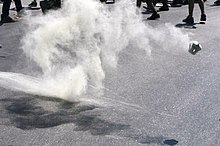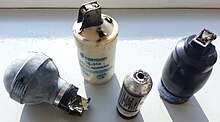Tear gas
This article needs additional citations for verification. (July 2012) |



Tear gas, formally known as a lachrymatory agent or lachrymator (from lacrima meaning "tear" in Latin), is a non-lethal chemical weapon that stimulates the corneal nerves in the eyes to cause tears, pain, and even blindness. Common lachrymators include OC, CS, CR, CN (phenacyl chloride), nonivamide, bromoacetone, xylyl bromide and syn-propanethial-S-oxide (from onions).
Lachrymatory agents are commonly used as riot control and chemical warfare agents. During World War I, more toxic lachrymatory agents were used.
Effects
Tear gas works by irritating mucous membranes in the eyes, nose, mouth and lungs, and causes crying, sneezing, coughing, difficulty breathing, pain in the eyes, temporary blindness, etc. Exposure on skin may cause chemical burns.[1]
Lachrymators are thought to act by attacking sulfhydryl functional groups in enzymes. One of the most probable protein targets is the TRPA1 ion channel that is expressed in sensory nerves (trigeminal nerve) of the eyes, nose and mouth.
Risks
As with all non-lethal, or less-than-lethal weapons, there is a risk of serious permanent injury or death when tear gas is used. [2][3] This includes risks from being hit by tear gas cartridges, which include severe bruising, loss of eyes, skull fracture, and death.[4] At close range or with severe exposure, there is a risk of scarring of the cornea, leading to a permanent loss in visual acuity.[5]
Use
Use in war
Use of tear gas in warfare (as all other chemical weapons) is prohibited by various international treaties[6] that most states have signed. Police and private self-defense use is not banned in the same manner. Armed forces can use tear gas for drills (practicing with gas masks) and for riot control. First used in 1914, xylyl bromide was a popular tearing agent since it was easily brewed.
The US Chemical Warfare Service developed tear gas grenades for use in riot control in 1919.[7]
Use in riot control

Certain lachrymatory agents are often used by police to force compliance, most notably tear gas.[8] In some countries (e.g., Finland, Australia, and the United States), another common substance is mace, which is the same as CN and is used as a self-defense weapon, in small spray cans. Xylyl bromide, CN and CS are the oldest of these agents, and CS is the most widely used.
Typical manufacturer warnings on tear gas cartridges state "Danger: Do not fire directly at person(s). Severe injury or death may result."[9] Such warnings are not necessarily respected, and in some countries, disrepecting these warnings is routine. In the 2013 protests in Turkey, there were hundreds of injuries among protestors targeted with tear gas projectiles.[10] This also happened during the 2013 protests in Brazil.
Counter-measures

The most obvious counter-measure is to prevent contact with the gas by leaving the area. Alternatively, a variety of protective equipment may be used, including gas masks and respirators. In riot control situations, protestors sometimes use a wide variety of equipment (aside from simple rags or clothing over the mouth) such as swimming goggles and adapted water bottles.[11]
Treatment

Once a person has been exposed, a variety of treatments may be used.
Activists in the United States, the Czech Republic, and Turkey have reported using antacid solutions such as Maalox diluted with water as a remedy for tear gas attacks.[12][13][14] Milk, ayran, lemons, lemon juice and vinegar are also used, but their effectiveness is disputed.
See also
References
- ^ E Worthington and P A Nee, "CS exposure--clinical effects and management.", J Accid Emerg Med. 1999 May; 16(3): 168–170.
- ^ "Possible lethal effects of CS tear gas" (PDF).
- ^ Hu et al (1989), Tear gas—harassing agent or toxic chemical weapon? JAMA 262(5)
- ^ Clarota et al (2003), "Lethal head injury due to tear-gas cartridge gunshots", Forensic Science International, Volume 137, Issue 1, 14 October 2003, Pages 45–51
- ^ OKSALA, A. and SALMINEN, L. (1975), EYE INJURIES CAUSED BY TEAR-GAS HAND WEAPONS. Acta Ophthalmologica, 53: 908–913. doi: 10.1111/j.1755-3768.1975.tb00410.x
- ^ e.g. the Geneva Protocol of 1925: 'Prohibited the use of "asphyxiating gas, or any other kind of gas, liquids, substances or similar materials"'
- ^ Daniel P. Jones (1978), "From Military to Civilian Technology: The Introduction of Tear Gas for Civil Riot Control", Technology and Culture, Vol. 19, No. 2 (Apr., 1978), pp. 151-168. Article Stable URL: http://www.jstor.org/stable/3103718
- ^ Hu, H (1989). "Tear gas--harassing agent or toxic chemical weapon?" (PDF). JAMA 262(5). pp. 660–3.
{{cite web}}: Unknown parameter|coauthors=ignored (|author=suggested) (help); Unknown parameter|month=ignored (help) - ^ CNN, 28 January 2011, Controversial tear gas canisters made in the USA
- ^ Turkish Doctors' Association, 16 June 2013, TÜRK TABİPLERİ BİRLİĞİ’NDEN ACİL ÇAĞRI !
- ^ Hurriyet Daily News, 30 May 2013, Gezi park protesters bring handmade masks to counter police tear-gas rampage
- ^ David Ferguson (2011-09-28). "'Maalox'-and-water solution used as anti-tear gas remedy by protesters". Raw Story.
- ^ "Medical information from Prague 2000".
- ^ Ece Temelkuran (2013-06-03). "Istanbul is burning". Occupy Wall Street.
Further reading
- BBC information about CS gas
- How to combat CS gas at eco-action.org
- Brone et al (2008)
